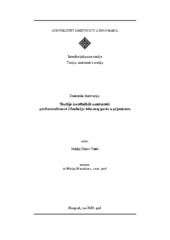Studije izvođačkih umetnosti: performativnost i funkcija telesnog gesta u pijanizmu
докторска дисертација
Метаподаци
Приказ свих података о записуДокторанд:
Dinov Vasić, MarijaФакултет:
Интердисциплинарне студије Универзитета уметностиДатум одбране:
08-11-2019Ментор:
Masnikosa, MarijaЧланови комисије:
- Popović Mlađenović, Tijana
- Daković, Nevena
- Marković, Marina
- Medić, Ivana
Сажетак
Doktorska disertacija Studije izvođačkih umetnosti: Performativnost i funkcija telesnog gesta u pijanizmu je diskusija o telesnim pokretima (kinestetičkim gestovima) koje u svojim izvođenjima demonstriraju pijanisti, kako bi u jednoj sinergijskoj (auditivno-vizuelnoj) izvođačkoj formi otelotvorili muzičko-poetski sadržaj. Naučna rasprava izvedena je u formi fenomenološke studije, a za predmet istraživanja određena je pijanistička izvođačka umetnost. Temeljni postulati pijanizma sagledani su kroz prizmu njegovog esencijalnog fenomena – pijanističkog gesta. Definicija ovog fenomena izvedena je preko Šenkerove teze prema kojoj suština pijanističkog izvođačkog gesta proizilazi iz ideje da smisao fraze determiniše poziciju i pokret ruke. Tako je utvrđeno da su pozicija i pokret ruke (materijalni, telesni nosioci muzičkog gesta), uslovljeni oblikom fraze (kao simboličke muzičke ideje), a da je adekvatna artikulacija (oblikovanje) performativnog izraza u direktnoj vezi sa konotativnim poljem ...koje određena muzička ideja može da simbolizuje. U postupku kreiranja adekvatnog metodološkog aparata nakon konstruisanja teorijske platforme u okviru koje je definisan koncept telesnog gesta u pijanizmu, usledilo je uodnošavanje rezultata dobijenih istraživanjem empirijske građe sa teorijskim osnovama rada. Uvidom u video snimke na kojima je zabeleženo devetnaest različitih izvođenja istih muzičkih dela (prve zbirke Debisijevih Prelida) sagledane su neke od opštih propozicija vezanih za pijanizam, a potom je komparativnom analizom četiri reprezentativna snimka (sekundarnom selekcijom izdvojenih iz prethodne grupe kompozicija) otvoren prostor za teoretizaciju o specifičnostima partikularnih funkcija proučavanog fenomena. S obzirom na to da su oblik, artikulacija, dimenzije i ekspresivna priroda izvođačkih gestova kvalifikovane kao konstantne vrednosti u analiziranim video snimcima (to jest u onim kadrovima u kojima su ovi parametri komparacije vizuelno dostupni), evidentno je da se argumentovani odgovori na ključna pitanja inicirana u ovoj disertaciji - a koja su koncentrisana oko ideje da su u muzičkom izvođaštvu pokret ruke i muzička fraza, kao dva tipa gesta, međusobno direktno zavisni i uslovljeni - mogu tražiti kroz njihovu analizu. Osim toga, saznanja kristalizovana kroz opisivanje, objašnjenje i komentarisanje ovih parametara, moguće je dokumentovati adekvatnim sekvencama iz odabranih video snimaka. Takav metodološki model konačno pruža odgovarajuću sponu između teorijskog aspekta disertacije i njenog
3
empirijskog utemeljenja. Analiza mogućnosti materijalnog otelovljenja apstraktnog muzičkog gesta u konkretnoj pijanističkoj situaciji, već na ovako ograničenom istraživačkom uzorku ukazuje na značajan kreativni potencijal koji nosi sam fenomen izvođenja muzike. Svaki kreirani pijanistički gest može predstavljati zasebnu istraživačku temu i tek nakon opservacije izvesnog broja ovih gestova koji je precizno određen metodologijom, moguće je govoriti o njihovim distinkcijama i konačnoj kategorizaciji. Naročito izazovno se ispostavilo traganje za uzrocima uočenih pojava, što ovu temu čini atraktivnom i potentnom za dalja istraživanja.
Doctoral Dissertation Studies of Performing Arts: Performativity and the function of the body gesture in pianism is a discussion of body movements (kinaesthetic gestures) which pianists use in their performances in order to create the musical-poetic content in a synergistic (audible and visual) performing form. This scientific discussion is carried out in the form of a phenomenological study, which focuses on the performing art of pianists as its research subject-matter. The basic postulates of pianism were examined through the prism of its essential phenomenon - a pianist’s gesture. The definition of this phenomenon is derived from Schenker's thesis according to which the essence of a gesture in piano performance arises from the idea that the meaning of the phrase determines the position and motion of the hand. It is thus established that the position and movement of the hand (material, physical carriers of the musical gesture) are conditioned by the form of the phrase (as a symbolic ...music idea), and that the adequate articulation (shaping) of the performative expression is directly related to the connotative field that a particular music idea can symbolize. In the process of creating a satisfying methodological apparatus after constructing the theoretical platform within which the concept of body gesture in pianism was defined, the results obtained by empirical research were observed from the perspective of the theoretical background. By inspecting videos of nineteen different recorded performances of the same musical pieces (the first collection of Debussy’s Preludes), some of the general propositions related to pianism were revised, and then, by means of comparative analysis of four representative video materials chosen from the previous group of compositions in secondary selection, the way was opened for theoretical explication of the specificity of the particular functions of the studied phenomenon. Since the shape, articulation, dimensions and expressive nature of the pianist’s gestures are qualified as constant values in the analysed videos (that is, in those frames in which these comparative parameters are visually available), it is evident that the underpinned answers to the key questions which are initiated in this dissertation - concentrated on the idea that in a musical performance the movement of hand and a musical phrase, as two types of gesture, are mutually directly dependent and conditioned - can be sought through their analysis. In addition, the knowledge crystallized through describing, explaining and commenting on these parameters
5
can be documented by the adequate sequences from selected video clips. Such a methodological model finally provides an appropriate conjunction between the theoretical aspect of the dissertation and its empirical foundation. The analysis of the possibilities of the material embodiment of an abstract musical gesture in a concrete pianistic situation, even in such a limited research sample, indicates a significant creative potential carried by the very phenomenon of musical performance. Any created pianist’s gesture can be a separate research topic and only after observing a certain number of these gestures, precisely defined by the methodology, would it be possible to speak of their distinctions and eventual categorizations. What makes this topic attractive and potent for further explorations is the challenging quest for the causes of the perceived phenomena.

